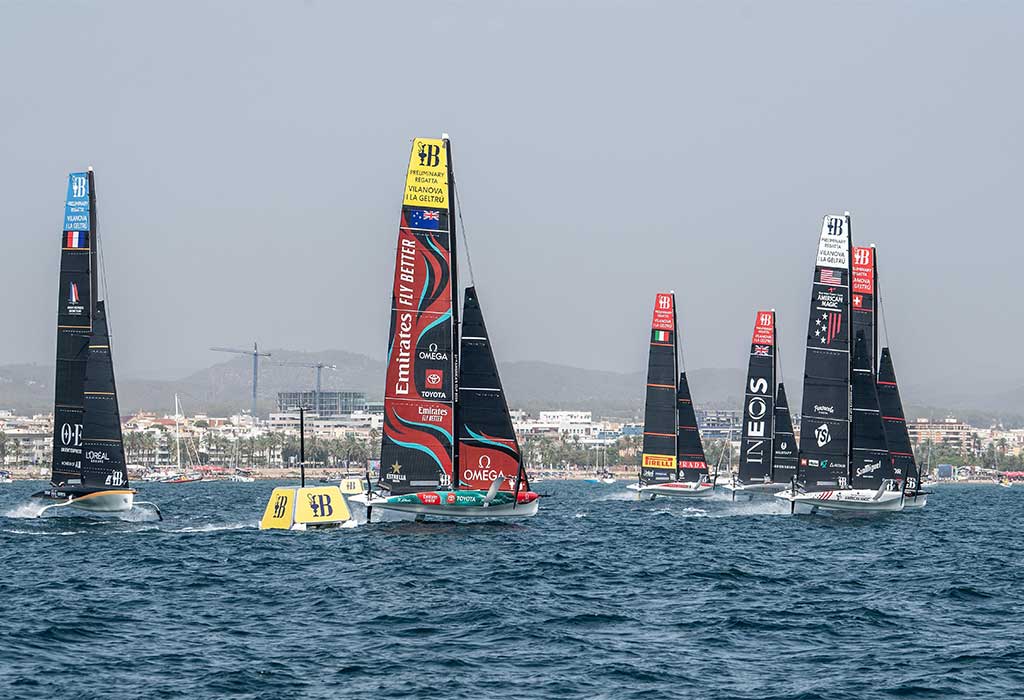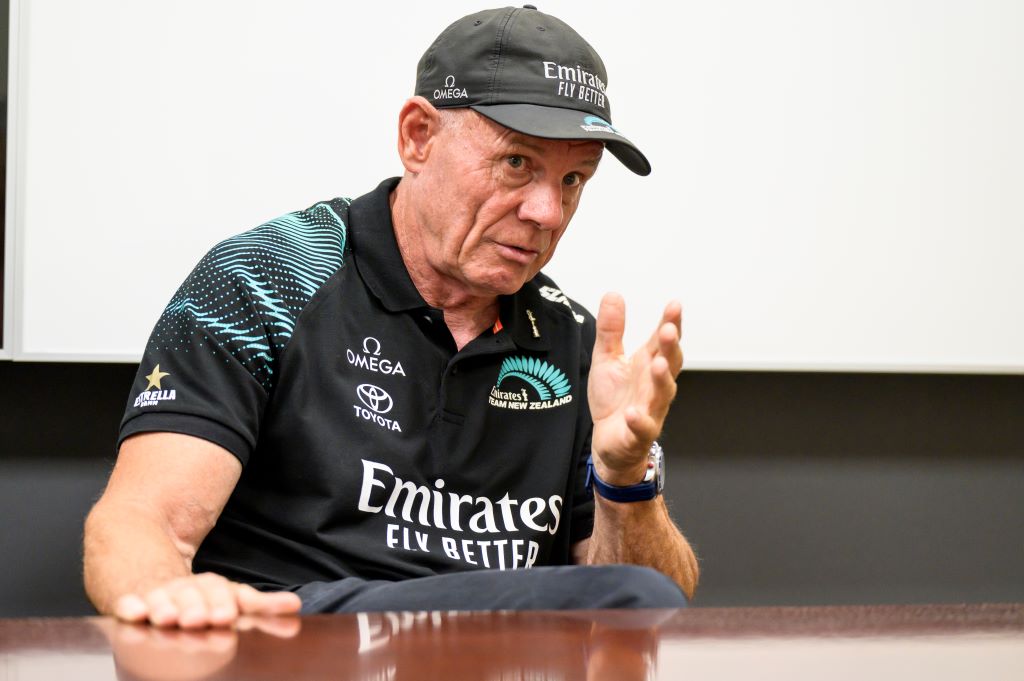
IESE Insight
Lessons from the America’s Cup for leading high-performance teams
Grant Dalton shares leadership lessons from his distinguished career in high-level sailing and as CEO of the America’s Cup.
World-renowned sailor Grant Dalton didn’t always hold a favorable view of the America’s Cup, the vaunted competition he now helms. A veteran of seven around-the-world races, Dalton felt it lacked the spirit of camaraderie that marked competitive circumnavigation. In 2003, however, he was tapped to restructure Emirates Team New Zealand after it had lost the Cup.
He made it a priority to refocus on the innovation for which the team was known, because when it comes to innovation, you can “never stop,” Dalton commented when he spoke at an IESE Alumni Learning Program in Barcelona, where he imparted leadership lessons based on his distinguished career both in high-level sailing and as CEO of the America’s Cup organization.
Under his leadership, Emirates Team New Zealand eventually reclaimed the Cup, which it will be defending when the 37th America’s Cup comes to Barcelona in 2024. “It took us 14 years to get the Cup back (in 2017). We had to stick it out until we became dominant again. And the big change between nearly winning it and then starting to dominate was to take risks and live on the edge,” he says.
Restructuring Emirates Team New Zealand
When Dalton was brought in to restructure the team, he opted to rebuild from the ground up. “I told them the first thing I was doing was firing all the directors. I wanted the ability to step in and clean house,” he recalls.
His next important step was bringing in good people for the right jobs and empowering them. Taking a long-term view was also crucial.
A key strength of any team when it comes to innovation is the ability to say no, Dalton says. “A lot of teams end up with a lot of projects they have never done and resources that have been badly managed because most of them have got more money than they know what to do with. They never say no and they don’t prioritize.”
“Because we’re a limited-resource team, we prioritize and say no a lot. So, for every three projects that come to the table, we’ll say no to at least two of them.”
He cites two common reasons that projects are rejected: not being able to achieve demonstrable results, and not being able to get them done within the required timeframe.
America’s Cup, a race of technology as much as of sailing
As the oldest continuous competition in modern sports, the America’s Cup underwent a high-tech transformation in 2013, when hydrofoils were introduced by Emirates Team New Zealand. The class of yacht now used is the AC75 foiling monohull — a boat that essentially flies, thanks to movable foils and reduced friction, at speeds of over 50 knots or 93 kph. Teams also increasingly employ artificial intelligence (AI) to fine-tune performance.
Today, America’s Cup is a race of technology as much as of sailing (IESE has produced a case study on this very aspect). Dalton puts it this way: “We’re a technology organization that goes sailing.”
Indeed, of the 160 people on Emirates Team New Zealand, only 12 are sailors, including the helmsman, trimmers and grinders. The rest are engineers and technicians, along with lawyers and administrators.
Due to the roughly four-year cycle of the Cup, teams start planning knowing that the technology they will ultimately use to compete probably hasn’t been invented yet. The use of AI tools in yachts has amplified this trend.
Apart from technological advances transforming the nature of the sport, Dalton points out that tech also helps to bring in more diversity: “As the power mechanisms of the boats become more automated, the more we can integrate women,” he says.
He admits there has been “a real lack of diversity within the sport of sailing, with a lot of tokenism.” Yet, he adds, “As the pinnacle of the sport, we are in a position to do something about it. We don’t have to ask for permission, we can just do it.”
To this end, in collaboration with the 37th America’s Cup, the inaugural Puig Women’s America’s Cup will be held with the aim of boosting women’s inclusion in the sport. (Puig, the family-owned fashion and fragrance business, has a history of giving back to society and supporting talent, with CEO Marc Puig serving on IESE’s International Advisory Board, and the company sponsoring the Puig Chair of Global Leadership Development, currently held by IESE Prof. Anneloes Raes.)
A no-blame culture
To gain an edge in the technological battle that is the America’s Cup today, Dalton stresses fostering an environment where mistakes become chances to learn.
“We’re an organization that has a no-blame culture,” he says. “Many companies are top-down organizations that make people petrified of making mistakes. We’re flat and accustomed to a degree of chaos. If an idea doesn’t work, it’s not a problem but an opportunity.”
In the early stages of the development cycle, the team isn’t restrictive, giving engineers room to throw ideas around and be their most creative, he explains. Later, processes around viable new ideas become highly disciplined to establish reliability.
Dalton rejects the notion of refinement or incremental innovation: “Refinement almost indicates you’re slowing down; you’re not delving and prodding and looking out.”
He describes his team’s motto as “throw the ball as far as you can, and then try to get it.” This means the team will reach for new ideas wherever and however they can, generating innovation that can be implemented within the tight timespan of the next campaign.
“Often, industry people think, ‘If I didn’t invent it, then it can’t be very good.’ Engineers tend to be a bit like that,” he says. “But we don’t have that philosophy. If someone else has got a better idea, we’ll happily steal it. We see ideas here, there and everywhere. And through that dynamic iteration process, hopefully we will create a faster, better boat.” (See the sidebar on corporate espionage, below.)
Winning vs. just competing
Under the terms of the competition’s founding document, written on parchment in 1851, the defending team sets the rules and chooses the venue for the next Cup — a unique protocol in sports. This is how Dalton is able to head up both the America’s Cup organization and Emirates Team New Zealand, and how he got to choose Barcelona over Auckland as the 2024 venue — a decision for which he took some flak.
He justifies his decision with pragmatic reasons: Apart from serious financial constraints the team faced as a result of New Zealand’s pandemic restrictions, he felt all team members would stay more focused on competition away from the distractions of home. He bristles at the suggestion the team should have stayed home and “just competed.”
“How could I walk through the door and tell the team, ‘Let’s just compete’? Why would anyone want to do that? How could any high-achieving sports team be geared to do anything but give the very best of itself — to win.”
Impact of the America’s Cup on the host city of Barcelona
Wherever the Cup goes, it becomes an impetus for speeding the development of the host cities. By one estimate, the 37th America’s Cup could have a potential economic impact of €1.2 billion on Barcelona, while also boosting the city’s image on the world stage.
Barcelona was chosen due to its commitment to sustainability, including the city’s strategy for driving a blue economy — the sustainable use of ocean resources for economic growth — which is closely aligned with the values of the Cup, Dalton says. He also credits an effective public-private partnership of local entities working together to bring the Cup to the city.
“It’s turning out to be an inspired decision to come to Barcelona, because there’s such an appetite” for the event, he says. The packed auditorium of enthusiastic IESE alumni, who were all clearly superfans, would appear to affirm Dalton’s decision was the right one.
Grant Dalton, on leaving a legacy
Looking to the future, as the America’s Cup becomes more technologically intensive, Dalton predicts the average age of followers will get younger — “and so it should.”
Regarding his own legacy, the 66-year-old Dalton says: “I won’t leave a legacy, I’ll leave a team, hopefully in a better place than I found it. Because I found a broken and destroyed team, and now I’ve got a strong, happy, friendly, striving team.”
“When I go — and I will — I will do something else,” he says, even if it is just sitting in a chair eating vegetables, he jests. “But I hope the legacy I leave is a strong team that can go on and achieve even greater things.”

Corporate espionage, an accepted part of the America’s Cup tradition
Spying on other teams to get an edge on new boat designs and equipment has always been an accepted part of the America’s Cup tradition. But secret surveillance teams have been banned from the 37th Cup to reduce costs and safety risks — although, in keeping with the spirit of friendly rivalry, each team will be assigned a boat and a photographer to collect images and data on competitors, and that information will be shared with everyone via the cloud.
Dalton regaled the audience with a few corporate espionage stories from the past. In one instance, members of Emirates Team New Zealand toured an apartment they were thinking of renting near their base — only to discover it had been fully outfitted by the current occupant with eavesdropping equipment and ultra-long lenses to spy on Dalton’s team.
Another time, a spying scuba diver wasn’t able to get off Dalton’s boat quick enough as it was being lifted out of the water. The frogman was promptly marched off to the police, where he had to hand over his camera.
And in yet another sneaky move, spies installed cameras in two portholes of their boat docked nearby so that, as Dalton’s yacht left port, they could snap pictures as it drifted past the first and second portholes, thereby enabling them to calculate the exact dimensions of his boat, based on vectors and speed. “It was pretty cunning,” Dalton admits. Sometimes you’ve got to admire the ingenuity of the competition.
MORE INFO: IESE has produced a multimedia case study on the America’s Cup, which highlights the growing importance of data-driven decision-making in the evolution of the event. For this case, students are tasked with data-modeling the 37th America’s Cup, including choosing the yacht with the highest probability of winning. “Flying across the sea” (AD-382-E), by IESE Prof. Rafael de Santiago, is available from IESE Publishing.
A version of this article is published in IESE Business School Insight magazine (Jan.-April 2024).
